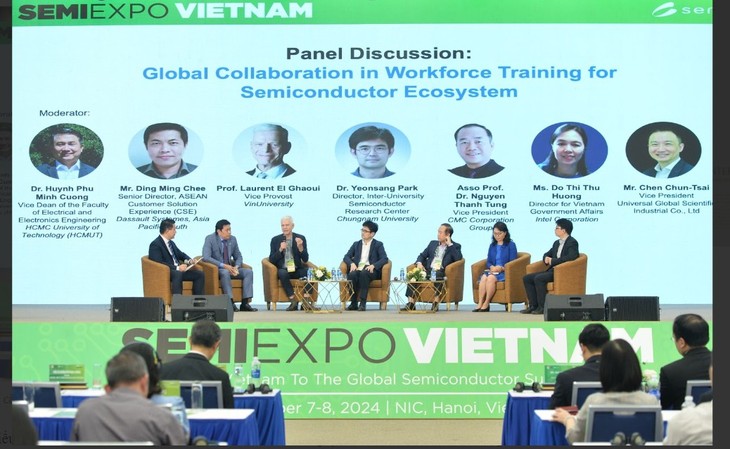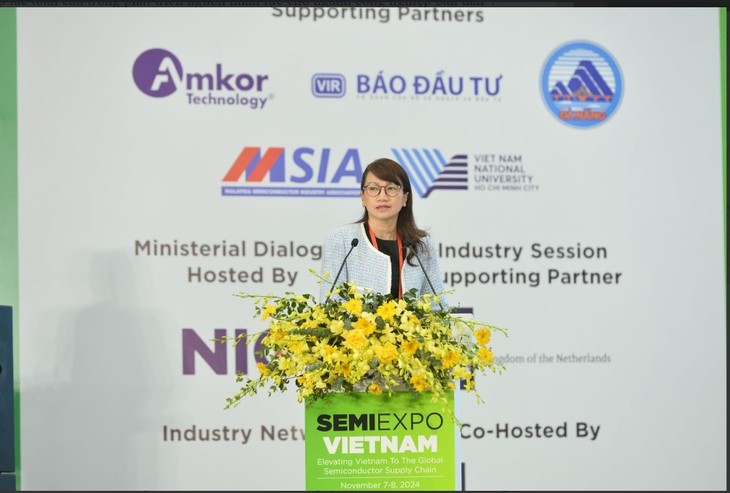 An overview of the panel discussion on training high-quality human resources for the semiconductor industry (Photo: NIC) An overview of the panel discussion on training high-quality human resources for the semiconductor industry (Photo: NIC) |
Advantages for development of semiconductor chip industry in Vietnam
Vietnam will need an estimated 30,000-50,000 semiconductor engineers by 2030. Last October, the government said it plans to train 50,000-100,000 highly skilled workers in the 2025-2030 period as Vietnam prepares for a wave of new investment in its semiconductor industry.
Vietnam, obviously, has lots of advantages to develop a semiconductor industry. First, the government, which recognizes the importance of human capital development in this industry, has promulgated initiatives like the National Semiconductor Program to develop talent through financial support and training programs.
At a recent forum on training high-quality human resources for the semiconductor industry, part of SEMIExpo Vietnam 2024, Deputy Minister of Planning and Investment Nguyen Duc Tam said investing in and supporting human resources is the key to a brighter and more sustainable future, which will greatly benefit Vietnam and its businesses.
Second, Vietnam has a young and rapidly growing population, eager to learn and adapt to new technologies. This presents a vast pool of potential talent for the semiconductor industry.
And third, compared to more developed countries, Vietnam offers a cost-effective environment for training and education. This makes it attractive to companies looking to build their workforce at a lower cost.
 An overview of the panel discussion on training high-quality human resources for the semiconductor industry (Photo: NIC) An overview of the panel discussion on training high-quality human resources for the semiconductor industry (Photo: NIC) |
Challenges identified to develop human resources extensively
Despite these advantages, Professor Dr. Nguyen Thi Thanh Mai, Deputy Director of the Vietnam National University - Ho Chi Minh City, said one of the biggest problems is a shortage of human resources, which currently meet only about 20% of the demand.
“Vietnam is facing many challenges in developing its semiconductor industry. There are five major ones. First, the global semiconductor industry has been growing rapidly, and Vietnam is far behind. Second, there’s a serious shortage in Vietnam of teachers and experienced experts in this field. Third, Vietnam’s laboratory facilities are outdated. Fourth, there’s only a weak connection between businesses and universities. And fifth, public awareness of the industry is still limited,” according to Ms Mai.
She said although the Vietnam National University - Ho Chi Minh City is a pioneer in training engineers in microchip and semiconductor design, with more than 20 years of experience, the number of teachers is so small you can count them on your fingers.
“We must develop a team of qualified teachers to train generations of excellent students,” said Ms. Mai, adding, “Our university plans to send younger lecturers to countries with advanced technology to study and improve their expertise. When they return they can improve Vietnam’s semiconductor training.”
According to Do Thi Thu Huong, government affairs manager at Intel Vietnam, “The government can foster collaboration by providing some kind of financing and curriculum development resources.”
“Another thing I think we can do is offer internships and scholarship. Intel could give dozens of students a year an internship in HCMC. These internships could provide students mentoring, training, and hands-on experience. Maybe the government can provide some kind of support for the program to encourage companies to hire the students. A third thing would be R&D collaboration between universities and companies to spur innovation,” said Ms. Huong.
Greater focus on training high-quality workforce
Dr. Huynh Phu Minh Cuong, Vice Dean of the Faculty of Electrical and Electronics Engineering, HCM University of Technology, says the semiconductor industry is a special field.
“The semiconductor industry needs a lot of investment to build education programs and other things. So the role of the government is very important. Education from the universities is not enough. The support of the industry is needed as well,” said Mr. Cuong.
Yeonsang Park, Director of the Inter-University Semiconductor Research Center at South Korea’s Chungnam University, stresses the importance of global cooperation in human resource training.
Park said, “In the case of Korea, during the early development of the semiconductor industry, the government tried to build good relations with international companies and send students to acquire experience at high-level technology companies.”
“I think it's the same in Vietnam’s case. In the early stage of development, the government must try to build good relations with global companies and then try to connect universities with those companies. I think that’s the most important thing,” Park noted.
Professor Laurent El Ghaoui, Dean of the College of Engineering & Computer Science at Hanoi’s VinUniversity, proposed that business associations form an alliance to promote the development of Vietnam’s semiconductor workforce.
According to the Professor, international collaboration shouldn’t be merely academic, but should come from a consortium of industries.
“I see many industries doing their own program, their own internship, their own thing. Why don't they assemble into a consortium? “Each puts in a little bit – to them it will be a very tiny investment – but if there are ten of them, it will be a lot. To me, that’s the best international collaboration – a consortium,” said Professor El Ghaoui.
Training high-quality human resources is essential for the success of Vietnam's semiconductor industry. It will require a collaborative effort from the government, educational institutions, and industry players to create a robust training ecosystem and attract and retain talent.